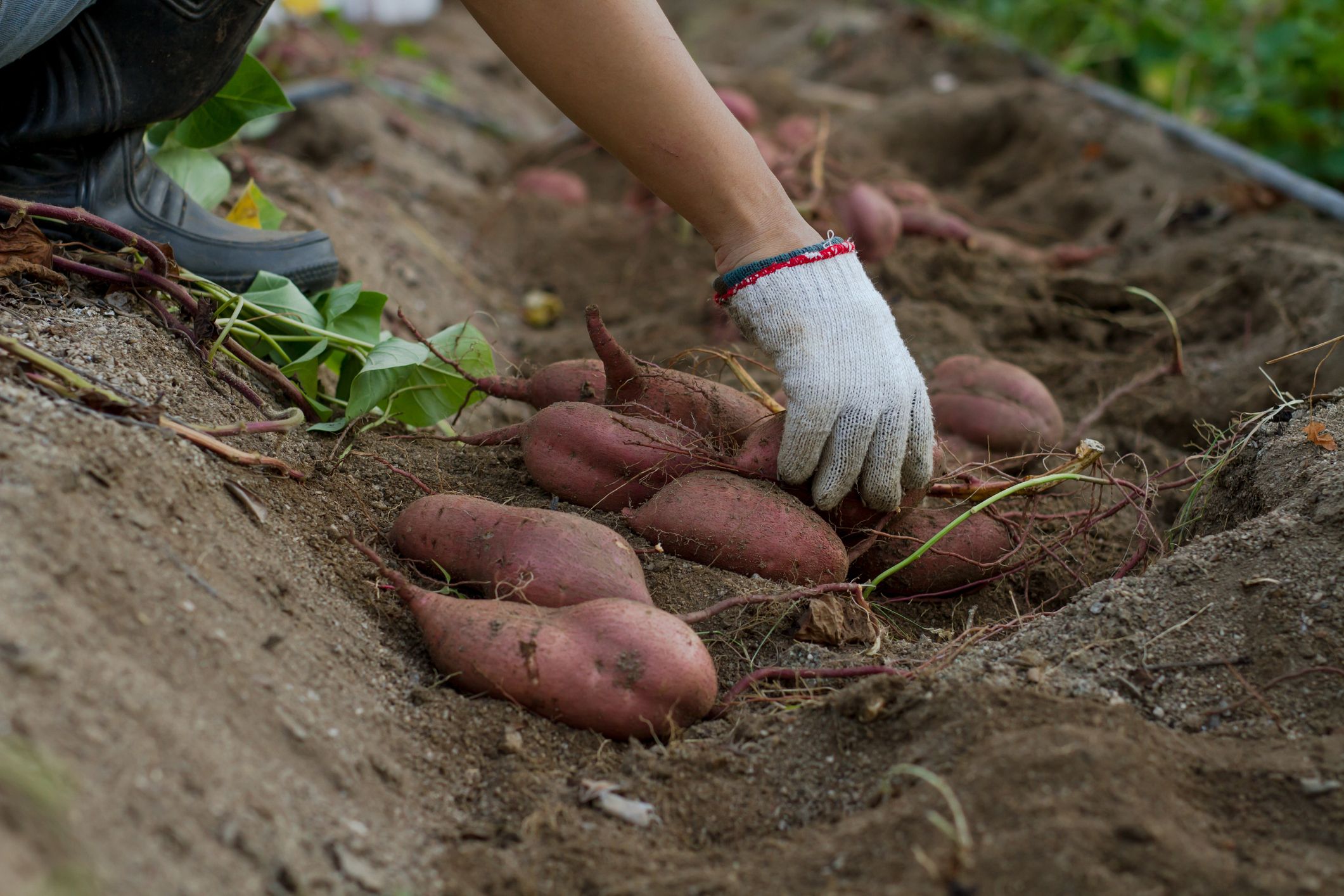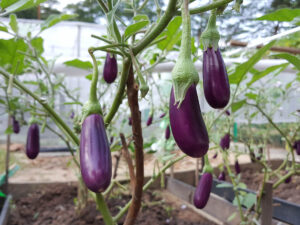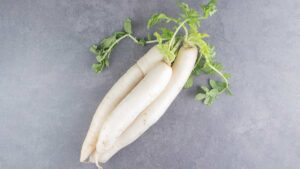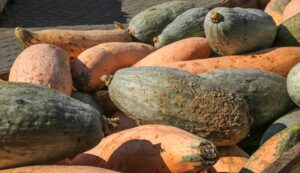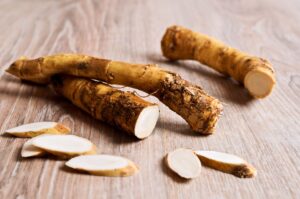How to Grow Sweet Yams: A Complete Guide for Home Gardeners
Sweet yams (Dioscorea species) are nutritious, versatile root vegetables that have been cultivated for thousands of years. In the United States, what many people call “yams” are actually sweet potatoes, but true yams are becoming increasingly popular in American gardens and kitchens. Whether you have a spacious garden, limited space for container gardening, or just a sunny windowsill, you can successfully grow these delicious tubers at home. This comprehensive guide will walk you through everything you need to know about growing sweet yams in various settings.
Understanding Sweet Yams
Before diving into cultivation methods, it’s important to understand what sweet yams actually are. True yams belong to the Dioscorea genus and are quite different from sweet potatoes (Ipomoea batatas), though they’re often confused in U.S. markets.
Sweet yams are climbing vines that produce starchy, elongated tubers underground. They’re nutritional powerhouses, rich in vitamins, minerals, and complex carbohydrates. According to the USDA’s Food Data Central, yams are excellent sources of vitamin C, potassium, and fiber.
Sweet Yam Varieties for U.S. Gardens
Several yam varieties can thrive in U.S. growing conditions, each with unique characteristics:
| Variety | Growth Period | Climate Preference | Size | Special Characteristics |
|---|---|---|---|---|
| Chinese Yam (D. polystachya) | 200-240 days | USDA zones 5-10 | 2-4 feet | Winter hardy, produces aerial tubers |
| Water Yam (D. alata) | 8-10 months | USDA zones 8-11 | Up to 5 feet | High-yielding, needs warm climate |
| Yellow Guinea Yam (D. cayenensis) | 8-11 months | USDA zones 9-11 | 2-5 feet | Sweet flavor, needs long season |
| Purple Yam (D. alata var.) | 8-10 months | USDA zones 8-11 | 2-3 feet | Purple flesh, ornamental vine |
| White Guinea Yam (D. rotundata) | 8-11 months | USDA zones 9-11 | 2-5 feet | Commercial favorite, needs support |
Growing Sweet Yams in Your Garden
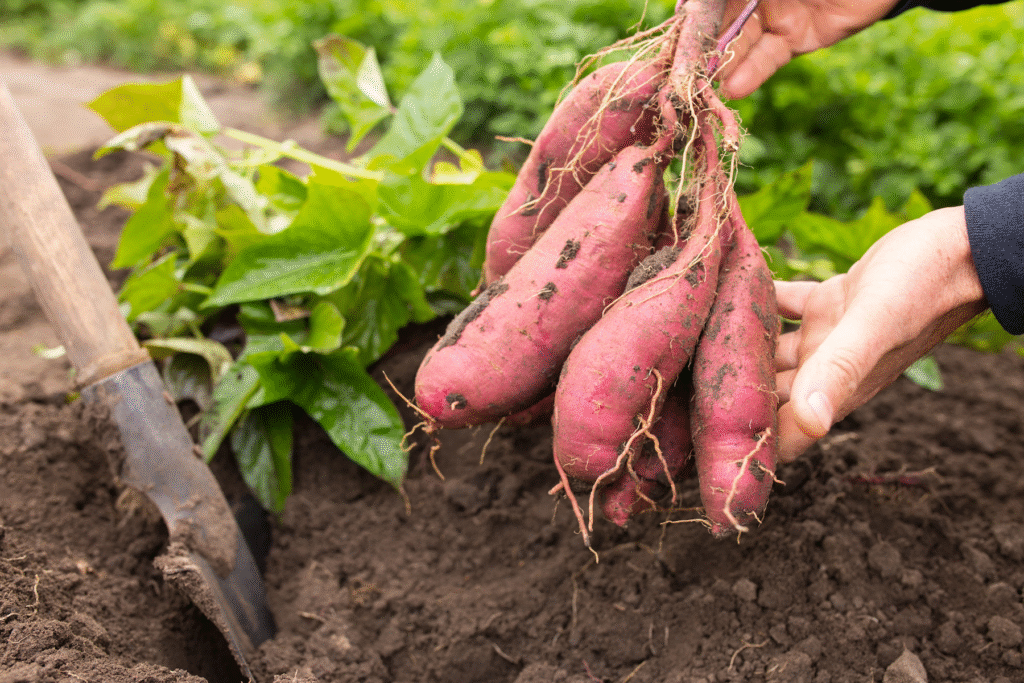
Site Selection and Preparation
For successful yam cultivation in your garden, follow these steps:
- Choose the right location: Select a spot that receives full sun (at least 6 hours daily) with well-draining soil.
- Prepare the soil: Yams prefer slightly acidic to neutral soil (pH 5.5-7.0). Work in plenty of compost or well-rotted manure to improve soil structure and fertility.
- Create mounds: Raise the planting area into 12-18 inch high mounds or ridges. This improves drainage and gives tubers room to develop.
- Install supports: Since yams are vining plants, install trellises, stakes, or other climbing supports at planting time.
Planting Sweet Yams from Seed Yams
Most sweet yams are grown from seed yams (pieces of mature tubers) rather than true seeds. Here’s how to plant them:
- Obtain seed yams: Purchase certified disease-free seed yams from a reputable supplier or use small whole yams from a previous harvest.
- Prepare the seed yams: Cut larger yams into 2-3 inch pieces, ensuring each piece has at least one “eye” or growth bud. Allow cut surfaces to dry for 24 hours before planting.
- Treating seed yams: To prevent rot, you can dust cut surfaces with wood ash or a fungicide approved for food crops.
- Planting time: Plant when soil temperatures reach at least 60°F (15.5°C), typically late spring in most U.S. regions.
- Planting depth: Plant seed yams 2-4 inches deep in prepared mounds, with growth buds facing upward.
- Spacing: Space plants 12-18 inches apart within rows and 3-4 feet between rows.
According to the USDA’s Agricultural Research Service, proper spacing ensures adequate airflow, reducing disease pressure and maximizing yields.
Caring for Garden-Grown Yams
Watering needs: Keep soil consistently moist but not waterlogged. Water deeply when the top inch of soil feels dry, typically providing about 1-1.5 inches of water weekly.
Fertilization schedule:
- Initial planting: Incorporate a balanced organic fertilizer into planting mounds
- Month 1-2: Apply a nitrogen-rich fertilizer to promote vine growth
- Month 3-4: Switch to a phosphorus and potassium-rich fertilizer to encourage tuber development
- Month 5+: Reduce fertilization to focus energy on tuber enlargement
Weed control: Keep the area around yam plants weed-free, especially during the first few months. Apply a 2-3 inch layer of organic mulch to suppress weeds and maintain soil moisture.
Vine management: Train vines onto supports as they grow. Yam vines can reach 10-15 feet in length and need guidance to grow vertically instead of sprawling.
Growing Sweet Yams in Containers
If you have limited garden space, you can successfully grow sweet yams in containers:
Container Selection and Setup
- Choose appropriate containers: Select containers at least 15-20 inches deep and 15-18 inches in diameter with drainage holes.
- Prepare the container: Fill with a high-quality potting mix blended with compost. Avoid garden soil, which may compact in containers.
- Add support: Place a trellis or stake in the container for vines to climb.
Planting and Care
- Plant seed yams: Place 1-2 seed yam pieces about 3 inches deep in each container.
- Water regularly: Container-grown yams dry out faster than garden plants. Check soil moisture frequently and water when the top 1-2 inches feel dry.
- Fertilize more frequently: Apply a balanced liquid fertilizer every 2-3 weeks during the growing season.
- Sun exposure: Place containers where they’ll receive at least 6 hours of direct sunlight daily.
- Winter protection: In colder regions (zones 5-7), move containers to a protected area like a garage or basement during winter months.
Growing Sweet Yams Indoors
For those in very cold climates or with no outdoor space, growing sweet yams indoors is possible, though yields will be smaller:
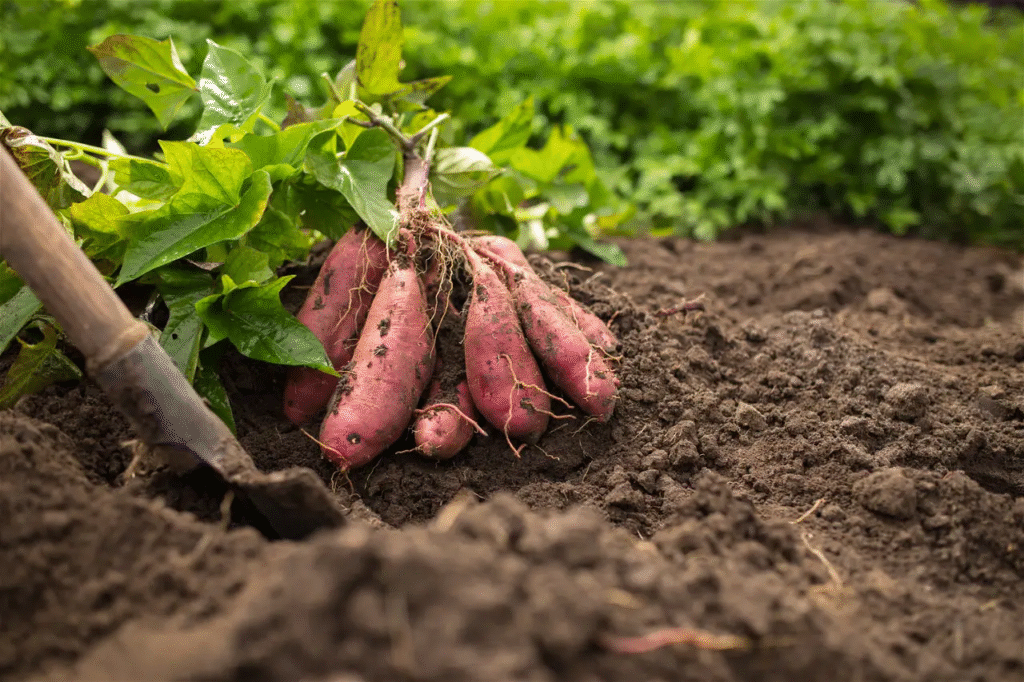
Indoor Planting Setup
- Location: Choose your brightest window, preferably south or west-facing. Supplemental grow lights may be necessary during winter.
- Container: Use a deep container (at least 18 inches) with excellent drainage.
- Support: Install a small trellis or place near a wall where vines can be trained to grow upward.
- Potting medium: Use a lightweight, high-quality potting mix with good drainage.
Indoor Care Requirements
- Light: Provide 10-12 hours of bright light daily. If natural light is insufficient, use full-spectrum grow lights.
- Temperature: Maintain temperatures between 70-85°F (21-29°C) for optimal growth.
- Humidity: Yams appreciate higher humidity. Consider using a humidifier or placing the pot on a tray filled with pebbles and water.
- Air circulation: Use a small fan to improve air movement and prevent fungal issues.
- Training: Regularly train vines along their support structure to maximize space efficiency.
Common Challenges in Yam Cultivation
Growing sweet yams can come with challenges. Here are some common issues and their solutions:
Pests:
- Yam beetles: Apply neem oil or introduce beneficial nematodes
- Aphids: Spray with insecticidal soap or a strong water stream
- Rodents: Protect tubers with hardware cloth barriers around planting areas
Diseases:
- Anthracnose: Improve air circulation and apply copper-based fungicides if necessary
- Tuber rot: Ensure proper drainage and avoid overwatering
- Viral diseases: Purchase certified disease-free seed yams and control insect vectors
According to the USDA National Institute of Food and Agriculture, integrated pest management practices can significantly reduce pest and disease problems in root crops like yams.
Harvesting and Storing Sweet Yams

When and How to Harvest
- Timing: Most yam varieties take 8-11 months to mature. Harvest when vines begin to yellow and die back.
- Harvesting technique: Using a garden fork, carefully loosen soil around the plants, then gently lift tubers to avoid damaging them.
- Curing: Let freshly harvested yams cure in a warm (80-85°F/27-29°C), humid location for 1-2 weeks to heal any cuts and develop a protective skin.
Storage Methods
Properly stored sweet yams can last 4-6 months:
- Temperature: Store at 55-60°F (13-15°C) in a dark, well-ventilated area.
- Humidity: Maintain 60-70% relative humidity.
- Containers: Store in open baskets, mesh bags, or crates that allow air circulation.
- Inspection: Regularly check stored yams and remove any showing signs of decay.
Sweet Yams in the U.S. Market
The market for true yams in the United States is growing as Americans explore international cuisines and seek diverse, nutritious foods. According to the USDA Economic Research Service, specialty crop markets, including tropical roots like yams, have experienced steady growth over the past decade.
Currently, most true yams in the U.S. market are imported, primarily serving Caribbean, African, and Asian communities. However, domestic production is increasing in southern states like Florida, Hawaii, and parts of California.
Growing your own sweet yams not only provides you with fresh, nutritious produce but also gives you access to varieties that may be difficult to find in conventional U.S. markets.
Conclusion
Growing sweet yams can be a rewarding experience whether you’re working with a garden plot, containers, or even growing indoors. With proper planning, care, and patience, you can enjoy these nutritious and versatile tubers straight from your own growing space. The key is selecting appropriate varieties for your climate, providing adequate growing conditions, and being attentive to your plants’ needs throughout their relatively long growing cycle.
By following the guidelines in this article, you’re well on your way to harvesting your own delicious sweet yams that can be used in a variety of culinary applications. Not only will you enjoy the satisfaction of growing your own food, but you’ll also be connecting with an agricultural tradition that spans thousands of years and numerous cultures around the world.
